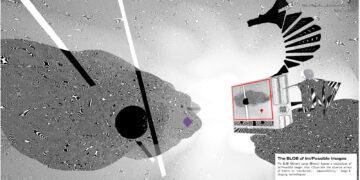Rosa Menkman
The BLOB of Im/Possible Images, 09.02.2021

The BLOB of Im/Possible Images by Rosa Menkman features some special and liminal images that the artist collected from her ongoing research. During her Art@CERN residency, Menkman researched impossible images, by asking scientists to imagine 'impossible' images of any object or phenomenon that they think are important. As a result of this exploration, Menkman created a low poly rendition of the unquantifiable blob of possible and impossible images that are very hard or simply impossible to resolve, due to constraints in the affordances of our image processing technologies.
Some of these images may have otherwise never found the way to our eyes, they may remain impossible or only exist in the hypothetical nooks of the BLOB, that functions as an archive of Im/Possible images. The work also comes with an open call for impossible images: with a form accessible from inside the BLOB, Menkman invites new submission to the archive. The BLOB of Im/Possible Images was visible from 09.02.2021 to 09.02.2021: newart.city/show/menkman-blob-of-im-possibilities
Rosa Menkman engages with the outcome of accidents in digital and analogue media. Her work takes common visual elements of digital images, such as glitches, distortions and colour errors, which are reframed and staged in various formats, including installations, video works, and online projects. The video work The Collapse of PAL (2010) uses various glitches along with audio track as narrative devices to tell the story of the now obsolete PAL signal. The artist also deals with the history of the processing and archiving of digital image data in various works such as DCT:SYPHONING (2015-2017). Under the title Glitch Moment(um) she published a book in 2011 that discusses the aesthetic and cultural relevance of glitch art, and established it as a genre.
Statement by the artist:
"My work focuses on noise artifacts that
result from accidents in both analogue and digital media (such as
glitch and encoding and feedback artifacts). I think the resulting
artifacts of these accidents can facilitate an important insight into
the otherwise obscure alchemy of standardization via resolutions. The
standardization of resolutions is a process that generally imposes
efficiency, order and functionality on our technologies. It does not
just involve the creation of protocols and solutions, but also entails
the obfuscation of compromises and the black-boxing of alternative
possibilities, which are as a result in danger of staying forever unseen
or even forgotten. Through this research, which is both practice based
and theoretical, I try to uncover these anti-utopic, lost and unseen or
simply 'too good to be implemented' resolutions, to find new ways to
understand, use and perceive through and with our technologies."